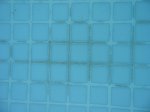My pool (ceramic tiles) has developed these stains in the material between the tiles (not sure what this is called).
Observing it from close it resembles sand. Initially i thought that the plaster was coming off, but then i realized that it is actually a deposit on top of the white plaster between the tiles. I have taken some shots with my trusty old digital camera (12 yrs old) for which I have an underwater case and I am attaching them in this post. I only got my Taylor K-2006 today so I did not get the chance to run a full set of tests yet. Will do that asap.
Any ideas what this might? I suspect metal/mineral deposits.
Assuming these are indeed some type of mineral deposits, any idea how I can get them out (without emptying the pool?) I tried to scratch them off underwater using a knife, but they are really tough and i ended up scratching the nearby tile, so i gave up.
Observing it from close it resembles sand. Initially i thought that the plaster was coming off, but then i realized that it is actually a deposit on top of the white plaster between the tiles. I have taken some shots with my trusty old digital camera (12 yrs old) for which I have an underwater case and I am attaching them in this post. I only got my Taylor K-2006 today so I did not get the chance to run a full set of tests yet. Will do that asap.
Any ideas what this might? I suspect metal/mineral deposits.
Assuming these are indeed some type of mineral deposits, any idea how I can get them out (without emptying the pool?) I tried to scratch them off underwater using a knife, but they are really tough and i ended up scratching the nearby tile, so i gave up.



